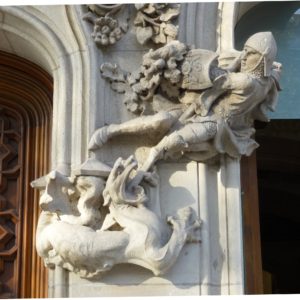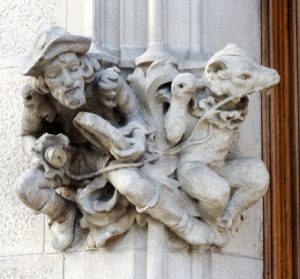Most people are familiar with the image of St. George and the dragon. Here’s one, for example, in Budapest:
Pretty classic, right? Guy on a big horse slays a wicked-looking reptile with a long spear from a pretty safe distance. (Well, not so much for the horse, of course, but they have to put the man and the beast into the same statue, right? So there are space constraints.
There’s a classic St. George on the facade of Casa Amatller in Barcelona, too. (Casa Amatller, designed by the architect Josep Puig i Cadafalch in about 1900, is right next door to Gaudi’s somewhat more famous Casa Batllo.)
Despite the lack of a horse, it’s pretty easily recognizable. The guy’s on the top, and he has armor and a shield. And (if you look closely) the obligatory spear, with which he has skewered the beast through the head and the heart.
When it comes to St. George and the dragon, let us be clear, there is not much of a contest. The beast is ferocious, but we are given the surety that the brave-hearted (and well armored) man wins.
But the artist is playing with us, as it turns out. There are not just one but three St. Georges with their dragons on the facade of Casa Amatller.
This second St. George appears to be a parody. It shows a rather extreme version of the man-over-beast story. The man is a performer with a tambourine not a spear, and the beast has turned into a dancing bear. No harm to anyone here. Not a chance of nightmares. But look at what has become of the man. He makes a living with this defeated creature, but that’s all. If the beast isn’t much of a dragon, neither is the person much of a man.
The third St. George speaks to me deeply. Here, the man wears only a thin cloak, and he is wrestling with a beast that is his own size, maybe bigger. It’s not clear who will win. Look closely. If the man is strangling the dragon, the dragon also has his claws into the man, raking his arm. Leaving wounds that could be slow to heal.
This one, at least, is an even contest.
This one feels real to me, for we all struggle with our beasts. We all struggle to be more than beasts ourselves. Every psychologist will recognize this conflict. Every artist will see in it the creative process. Even Plato described the act of creation as “reason persuading necessity.”
For a long time, I placed this image of the creative struggle on the top of my home page, but it’s dark, and it’s difficult. It may capture you, and it may draw you in, but not in a way that will invite you and make you feel at home.
Please do come in. Please do feel at home in these pages. There is much of beauty and of joy here. But let’s just remember that it’s not a dancing bear lurking there in the dark corners–it’s a dragon.




